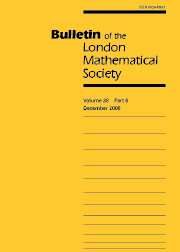Article contents
POLYHEDRAL METRICS AND 3-MANIFOLDS WHICH ARE VIRTUAL BUNDLES
Published online by Cambridge University Press: 01 January 1999
Abstract
Throughout this paper, all 3-manifolds are closed and orientable. Our aim is to give some new examples of 3-manifolds which are virtual bundles, that is, have finite sheeted covers which are surface bundles over the circle. Thurston has raised the question as to whether all irreducible atoroidal 3-manifolds might have this property. The geometrisation conjecture would imply that all such 3-manifolds have hyperbolic metrics, and the virtual bundle question is then equivalent to showing the existence of geometrically infinite incompressible surfaces (compare [14]).
Not much progress has been made on this problem. Recently, Reid [9] has given an explicit example using an arithmetic hyperbolic 3-manifold, and Cooper, Long and Reid [3] have given methods of constructing immersed incompressible surface in surfaces bundles over the circle, which are sometimes geometrically infinite. In [10], examples are given of horizontal immersed incompressible surfaces in graph manifolds which do not lift to embeddings in any finite sheeted covering spaces. Similar examples are given in toroidal manifolds with cubings of non-positive curvatures in [9]. So the assumption that the manifold has the atoroidal property is essential in Thurston's question. Our aim is to give several simple constructions of large classes of examples using different polyhedral metrics of non-positive curvature on 3-manifolds (compare [2]).
We follow closely the construction of Thurston (compare [13]), where he observes that the right-angled regular hyperbolic dodecahedron can be viewed as a cube with arcs drawn on each face through midpoints of a pair of opposite sides so that no two such arcs share a common vertex. Then the foliation of the cube by planes orthogonal to a diagonal gives an induced foliation of any 3-manifold arising from a torsion-free finite index subgroup of the symmetry group of the tessellation of hyperbolic 3-space by the right-angled dodecahedron. Clearly, any leaf of this foliation is then an immersed geometrically infinite surface. One explicit example is then the 4-fold cyclic branched cover of the Borromean rings, since the Borromean rings has a flat 2-fold branched cover which is obtained by gluing two cubes together. This example is formed by a subgroup of index 4 in the above symmetry group.
Our examples come directly from this observation of Thurston, using different ways of dividing a 3-manifold into simple polyhedra so that there is an overall metric of non-positive curvature. We use some well-known tessellations of Euclidean 3-dimensional space, described in Coxeter [4], by truncated octahedra and tetrahedra, plus flying saucers (compare [2]), as well as the easy case of cubes.
In the final section we show that our classes of cubed examples and flying saucers admit geometric decompositions in the sense of Thurston, since they are virtual bundles. We would like to thank the referee for a number of helpful comments which improved the exposition.
- Type
- Notes and Papers
- Information
- Copyright
- © The London Mathematical Society 1999
- 4
- Cited by




